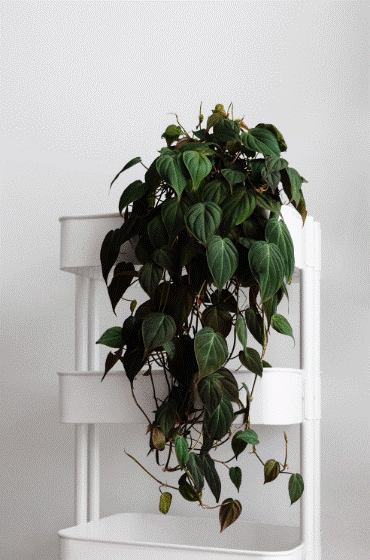Philodendron Micans And Other Indoor Types

Philodendron Micans, also known as Philodendron hederaceum var. or hederaceum. What makes philodendron micans special is their beautiful velvet finish.
In fact, the common name for the philodendron micans is the velvet leaf philodendron.
The leaves have a greenish-purplish finish with a bit of a shimmer (though not as much of a shimmer as the Scindapsus pictus silver satin pothos has).
Resilience and minimal need for attention aren’t the only reasons for the enduring popularity of philodendrons, although novice and experienced gardeners appreciate these durable, tolerant plants.
There are also many varieties to choose from. Challenging or simple, traditional green or multicolored, the characteristics of these plants are so diverse that there is a philodendron for every taste.
Since there are approximately 275 species, choosing a philodendron may be the most difficult task you face with this plant.
What’s more, many types of philodendrons have the unique characteristic of taking on a different leaf form as they mature.
INDOOR
Indoor gardeners may primarily think of them as green plants, but that’s no longer the case.
It is not uncommon to find philodendrons tinged or variegated with blue, gray, white, yellow, red, burgundy, pink, or purple leaves.
While the varieties may seem endless, their growth habits are not. Essentially, philodendrons do one of two things: they climb, or they don’t.
Climbers
A climbing philodendron gives a lift to any room and enlivens pretty but plain windowsills. A popular climber is Philodendron’s, Pink Princess.’
Its burgundy-black leaves are streaked with hot pink and touches of lavender and dark purple.
Climbers often are showcased in hanging baskets. The heart-shaped leaves of P. scandens micans, the smallest and most common plant in the family, are beautiful when left trailing.
The velvety, olive-green leaves have prominent, cream-colored veins. Similar climbing philodendrons include P. gloriosum and P. Anderson’s Red.’ P. glorisum makes a nice groundcover. P. `Anderson’s Red’ has longer leaves that are a deep burgundy.
The alternative to the climbing philodendron is the low, bushy philodendron. These plants do well in low-light corners of your home where many other plants won’t grow.
Growing
In ideal situations, some non-climbing philodendrons will grow to heights of 6 to 8 feet.
If bright, shiny plants intrigue you, the glossy elephant’s ear (P. hastaturn) may be for you.
Also called spade-leaf, its arrow-shaped leaves grow almost vertically and reach 8 to 12 inches long.
Eventually, the pale-green elephant’s ear will generate sweet-smelling tubular blossoms, which may be removed if you decide they detract from the plant’s appearance.
A common climber is the fiddle leaf (P. panduriforme), also known as twice-cut or horsehead.
Its leathery, medium-green leaves are deeply lobed, giving the appearance of a hand with outstretched fingers.
For a burst of color, invest in P. `Kaleidoscope,’ which produces an array of foliage colors and is exceptionally easy to grow. For the most beautiful whites, reds, yellows, oranges, and coppers, be sure to give this one plenty of light.
Foliage
The velvet-leaf (P. verrucosum) is less colorful but considered by some to have the most handsome foliage in the family.
However, that distinction may be questioned when its velvety, heart-shaped, deep-green leaves take on a crocodile pattern in maturity.
Once you’ve outgrown the Easycare philodendrons, try the more challenging ones. The rare P. elegans will test even the most experienced gardener’s abilities.
The large leaves of this vigorous climber are deeply dissected into narrow fern-like segments. P. `Burle-Marx’s Fantasy will also challenge gardeners.’
Although difficult to cultivate, the slow-climbing plant will reward dedicated efforts by producing elegant, shingle-fashioned foliage in a combination of olive-green and forest-green tones.
Maintenance
Whether your favorite philodendron is a climber or a non-climber, large or small, maintenance is simple for all but the more challenging varieties.
Philodendrons will grow in low light but thrive in bright, indirect sunlight. Water philodendrons moderately, allowing the top layer of soil to dry before watering again.
Germinate every 2 weeks with a liquid fertilizer. From November through March, stop feeding and water sparingly to let the plants rest.
It’s also important to maintain a 45- to the 55-percent level of humidity for philodendrons.
To increase the humidity, place a pebble tray filled with water beneath the plant.
Despite having originated in the tropical rain forests of South and Central America, the philodendron has adapted well to the American gardener’s home.
The plant is said not to tolerate sudden changes in its environment, so protect it from cold drafts in winter.
Climbers do have one extra requirement:
poles, usually made of osmunda fibers. The poles are generally sold with climbing philodendrons, but poles may be purchased separately.
Moss-covered poles also work well and add to the decorative quality of your climbing philodendron.
Regardless, it’s important to keep the pole moist; the aerial roots will seek moisture as the plant climbs.
Aerial roots are small, spikelike structures that protrude from stems and embed themselves into the bark in their natural habitat.
The aerial roots will grow into a supporting pole to encourage climbing. If moisture is lacking, rooting will not take place, and leaves will become disappointingly small.
To stop a plant from climbing farther, remove the aerial roots or direct them into the soil.
To maintain the beauty of the philodendron or to expand your collection, the propagating process is simple.
For climbers, stem cuttings will flourish during the summer. Non climbers propagate well in warm conditions with seeds or shoots from the stem base.
Philodendrons, whether maintaining or reproducing – are a cinch.


























